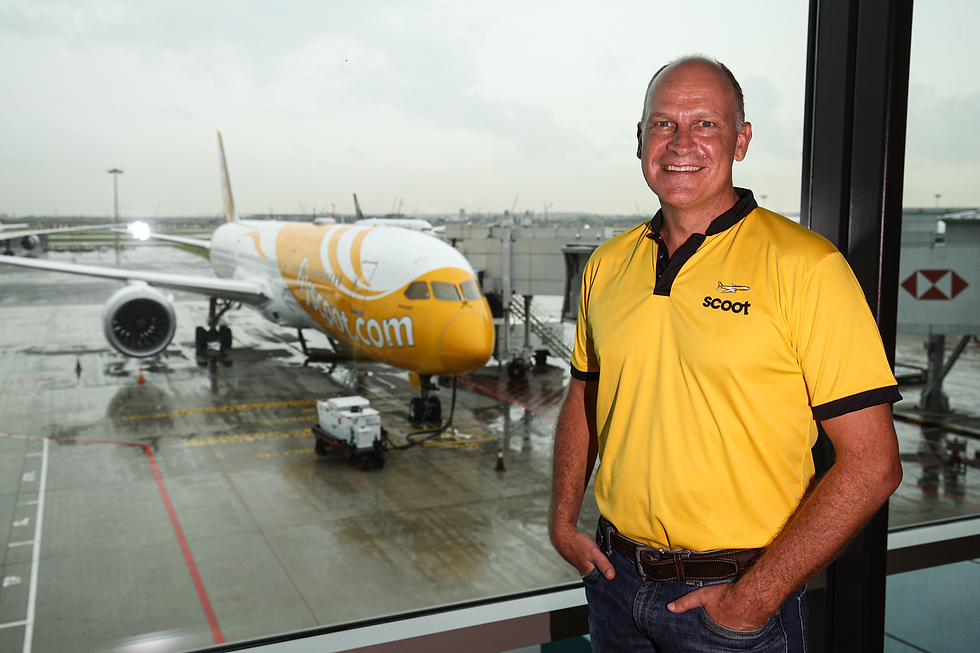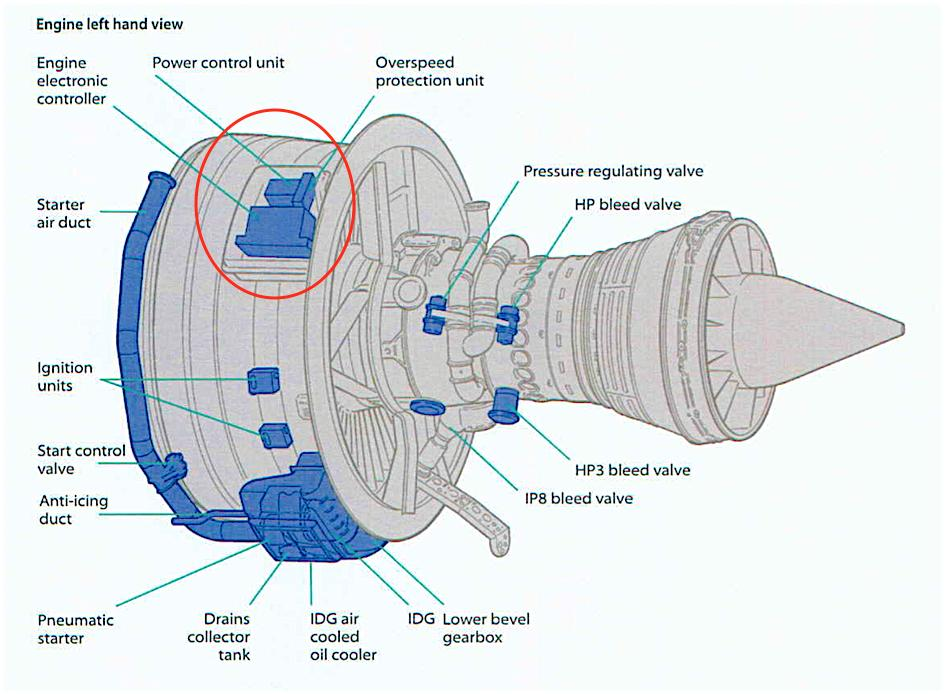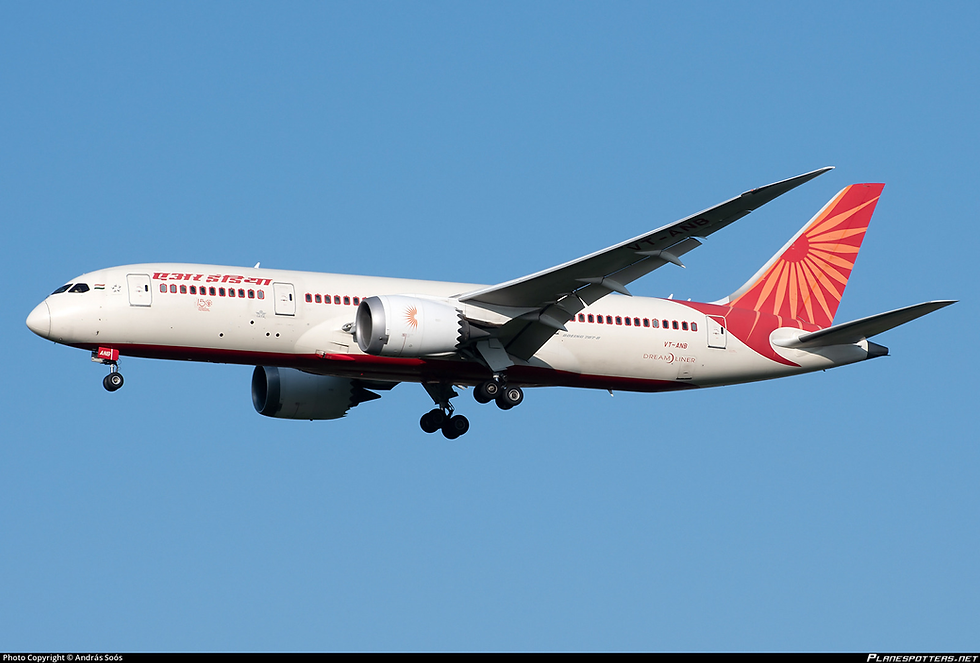The unbearable heaviness of being (an Air India CEO). Spotlight: Campbell Wilson
- Prashant Kavi (PK)

- Jul 27
- 8 min read
Updated: Jul 31

Singapore, 2014
It was in February of 2014, on the sidelines of an Aviation IT event in Singapore, that I first got to meet Campbell Wilson. He was then, the CEO of Singapore Airlines [SQ] owned LCC – Scoot [TR], also being its founding CEO. I was at the time pitching an Aviation ERP system for a former employer and we were very keen to present our solution to Scoot. We had been promised a one-on-one with Campbell Wilson by the event organizers as part of a networking opportunity, which was crucial for our cause, given that Campbell Wilson and Scoot were much in demand at the event and being chased by myriad other suppliers.
And unlike how it works with much of the C-suites at such events i.e., desultory interest and barely enough time given to even exchange cards, Campbell Wilson and his colleagues were gracious enough to hear out our brief pitch and display genuine interest. I recall being struck by Campbell Wilson's punctilious disposition, genteel demeanor and genial manners - quintessentially Kiwi!

By all available accounts, Campbell Wilson was a shining star at Singapore Airlines when he was hand-picked to launch Scoot, in what was a bite-the-bullet, paradigm (character) shift for Singapore Airlines to have launched an LCC. But then Singapore Airlines had started to feel the chill winds of competition in their neighborhood from a slew of LCCs, ergo Scoot. And true to his billing, he led the airline to a profitable start. He left a few years later to rejoin the parent, before being recalled to take the helm again at Scoot for a second stint, after apparently the airline started floundering and posting losses around 2019/20. A senior Singapore Airlines executive that I have had the opportunity to interact with closely, claims Campbell Wilson has 'ice-water veins' - a reflection of his ability to stay calm and composed in a crisis. This attribute will not only come in handy but is sure to be tested to the hilt at Air India!
Not the first choice for Air India
TATA's have always considered Air India as their displaced child and therefore when Air India returned to the TATA fold in January 2022, the hunt for a suitable candidate to lead the airline in its transformational journey, began in right earnest at Bombay House, the TATA group headquarters in Mumbai [BOM]. And reportedly, the then Chairman Emeritus of the group, Ratan Tata, himself was monitoring progress every step of the way.
But there was a bit of a fumble to start with, as the first choice to lead the airline, a former Chairman and board member of Turkish Airlines [TK] was selected and announced publicly. But given increasingly strained relations between India and Turkey and the resultant voices of dissent from various quarters including the high echelons of the Government, against hiring a Turkish national (and someone reportedly close to the incumbent Turkish President), the CEO-designate himself had the good sense to withdraw his candidature.

It is perhaps at this time that Ratan Tata turned to Singapore Airlines, with whom he'd enjoyed a long and warm relationship, and they had no hesitation in advancing the name of Campbell Wilson. Given that Singapore Airlines had also taken on a 25.1% stake in a restructured and consolidated Air India Limited, the objective was clearly to get the best man for the job. As Singapore Airlines Group CEO Goh Choon Phong said at the time, that while the group was sad to lose Wilson, he was going to Air India with their “full blessings”. And so it was on July 25, 2022 that Campbell Wilson ascended to the position of CEO & Managing Director of Air India Limited, undeniably one of the most challenging assignment in all of commercial aviation.
In a bit of a paradoxical development in 2022, Indian commercial aviation saw the appointment of two expatriate CEOs. Campbell Wilson transitioned from leading a low-cost carrier (Scoot) to heading a full-service carrier (Air India). Meanwhile, Dutchman Pieter Elbers, who previously served as President & CEO of KLM Royal Dutch Airlines, a full-service carrier, took over as CEO of India's leading low cost carrier - IndiGo in September, just a few months after Campbell Wilson.
Real-time resilience
A role fraught with complexities, the weight of history, and the ever-present deep gaze of public scrutiny; being the CEO of Air India is no ordinary task. The challenges are formidable and complex, rooted in the airline’s ambitious plans for transformation by getting rid of undistinguished legacy baggage and fighting in a fiercely competitive aviation landscape - both at home and abroad. As the airline seeks to revitalize and reinvent itself as a global carrier to rival the very best, Campbell Wilson will have to navigate a minefield of operational challenges, cultural shifts, and the imperative of modernising a vast, ageing fleet.

Starting with acclimatizing to a unpredictable and dynamic living environment in India as opposed to the predictable and clinical efficiency of Singapore, coming to grips with the huge cultural shift in itself is a massive challenge for any expatriate relocating to India, leave alone the multitude of challenges Campbell Wilson faces on various fronts.
Transformation: A pun-intended analogy of Air India’s transformation can be likened to the grand restoration of a vintage Indian Maharajah's palace - once majestic, a long time ago but faded and jaded under decades of government controlled bureaucratic nepotism and
neglect. The TATAs have stepped in not merely to renovate the façade but to gut the interiors, modernize the infrastructure and infuse new cultural energy while resurrecting the heritage that defines the structure. All under a five-year programme titled - 'Vihaan.AI'. Vihaan in Sanskrit means the 'break of dawn', therefore implying new beginnings for Air India. The process is mammoth, and multi-phase: from rebuilding backend systems, to refreshing front-end customer experience, rethinking network strategy and fleet acquisition. In many ways a reinvention rather than a revival - all of which demand a steady hand and clear vision. Success will hinge not just on strategic decisions but on the ability to inspire confidence and momentum, especially within the Air India team.
Service & Quality Issues: Perhaps a primer to what he would have to deal with was typified among others by the infamous Air India "pee-gate", where in two separate incidents on Air India international flights, unruly and intoxicated passengers urinated on fellow passengers! Then there have been persistent service and quality issues including broken seats, non-working IFEs, dirty interiors and clogged toilets. To be fair, many of these problems stem from legacy issues tied to an old, poorly maintained fleet and won't disappear overnight.
Organizational Issues: Aside from dealing with the vestiges of rampant factionalism, leftover from the legacy org structure, on the HR front there have been high-profile skirmishes with both the Cabin and Air Crew on allowances, flight duty times et al. Besides, the need to consolidate and integrate brands like: Air India-Vistara, and Air India Express-Air Asia, and drive synergy amidst vastly differing cultural values and mindsets.
Competition: In all of this the competition has also been unrelenting. At home, the LCCs led by a dominant IndiGo, a resurgent SpiceJet and a coming of age Akasa Air are snapping at the heals. IndiGo the biggest threat to Air India's international supremacy ex-India, has been making moves to partially reinvent itself by introducing a premium class on select domestic routes and flights. Its international ambitions are currently riding on wet-leased, wide-body

equipment from Turkish Air [TK] and Norse Atlantic Airways [N0]. A smart move to test the waters, build it's presence, reserve valuable international airport slots and improve operational efficiency until it gets its own Airbus A350s; 30 of them, to be inducted starting 2027. Meanwhile, on the international outbound traffic ex-India, there is stiffer competition from the big three (Emirates/EK, Qatar/QR, Etihad/EY) in the Gulf, who also equally recognize Air India as somewhat of an existential threat to their lucrative westbound India traffic feedering into their hubs. Air India has some solace on that front though, with the Indian Government declining to provide more slots to the Gulf carriers to operate out of Indian airports for now.
Target of Large-scale Disruptions: In 2024, Indian airlines and airports received close to a 1000 bomb threats. Air India was particularly hit hard, with much of these hoax calls targeting its flights thereby causing widespread network disruptions. October 2024 saw an unprecedented surge with over 500 calls alone, which also included the much publicized Air India flight from New Delhi [DEL] to Chicago [CHI] having to divert to an airport [Iqaluit (YFB)] in Canada and the passengers subsequently being transported on a Canadian Air Force jet for the last leg of their journey to the final destination.
External Operating Environment: Add to it the geopolitical upheavals, including the brief India-Pakistan conflict in early May this year, that led to the Pakistani airspace closure prior and subsequently some domestic Northern Indian airfields for a limited period. The Pakistani airspace closure continues, resulting in circuitous routes and longer flights, that have largely negated the earlier competitive advantage of Indian carriers (over their European and American rivals) being able to fly thru Russian airspace on Polar routes to Europe and North America, even as it remained closed to the others. Appreciably, Air India as the predominant international long-haul Indian carrier has had much more to lose from these developments than anyone else.
AI171 tragedy and the big test
Perhaps the most any Airline CEO dreads, is receiving news of a fatal air crash under their watch. But with the AI171 accident at Ahmedabad [AMD] on June 12, it was the timing that compounded the effect for Campbell Wilson. Just when he would have started feeling confident of getting the airline back on rails, this tragedy was a seismic shock across both Air India as well as TATA group HQs. Seemingly, all the achievements within the last couple of years instantly came under a cloud and the future suddenly started looking glum.

From navigating speculation and relentless media pressure to maintaining staff morale and rebuilding public trust alongside brand confidence, besides intensive regulatory engagements as part of the accident investigation; Campbell Wilson is faced with a tall and unenviable order.
Tackling a vociferous Indian media particualrly, can be a bit overwhelming for the unprepared and the uninitiated, as Campbell Wilson is perhaps discovering. From being (unfairly) castigated for his post-accident video message, which many sections of the media claimed was plagiarized from a similar message, delivered previously by American Airlines' CEO, to facing an onslaught of questions around poor maintenance, poor crew work-life balance and highlighting Air India's non-compliances with some regulatory rules. All, even before the preliminary report was out! Social media pressures on brand Air India are similarly enormous in the accident aftermath, with some influencers and YouTubers pronouncing (quite ridiculously), Air India to be unsafe. If anything, Air India has come under greater scrutiny after the accident and even the smallest of missteps are now being amplified to suggest a deep problem with the airline. In many ways, all this is stoking unwanted paranoia, affecting the brand and employee morale.
How does a CEO then manage the situation against such odds and that too at such a critical juncture in the airline's nascent transformation journey?
As Air India contends with the emotional ramifications of the accident, Campbell Wilson’s leadership must now carefully balance empathy with strategic clarity, responding to urgent concerns, even as he positions Air India for sustained, long-term progress.
Epilogue
In his 2005 Stanford commencement address, Steve Jobs discussed the concept of "the heaviness of being successful" being replaced by "the lightness of being a beginner again".
This quote reflects his personal experience following his dismissal from Apple in 1985. He characterized this transition as liberating, enabling him to embark on a more creative period of his life, during which he co-founded Pixar.
The quote highlights the idea that success, while often desired, can also bring with it a sense of pressure, expectation, and obligation. When that pressure is removed, perhaps through a significant change or setback, it can create space for new possibilities and a renewed sense of purpose. The quote emphasizes that success, although frequently sought after, can also carry a burden of pressure, expectations and duties. When that pressure is alleviated, possibly due to a major change or setback, it can open up opportunities for new possibilities and a refreshed sense of purpose.
The AI171 accident marks a critical inflection point - not just in the trajectory of Air India, but in shaping Campbell Wilson’s legacy as its CEO.








Comments